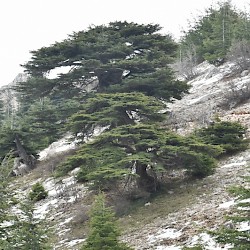Lebanon cedar
Lebanon Cedar (κéδρος; Cedrus libani): tree, well-known for its fragrance, and the strength and usefulness of its wood.

The tree
The Lebanon Cedar is a coniferous evergreen, with needle-like leaves with a remarkable blueish green color. When young, the tree has a conic shape, but when the trees grow old, they become almost tabular. The branches can reach out for some fifteen meters; the cedars can be up to forty or fifty meters tall and may have a diameter of about three meters.
Although the cedar is commonly associated with the Lebanon Mountain Range, the tree originally had a larger homeland, which included the Taurus Mountains. Deforestation, which already started in Antiquity, has reduced this area to several protected reserves in the mountains of Lebanon.
Use
Because cedars can be extremely tall, they could span great widths and were used to make the ceilings of large buildings. The Roman author Vitruvius writes:
The ceiling of the temple of Artemis at Ephesus, is made of it; and it is used in many other celebrated temples, on account of its great durability.note
Among these other celebrated temples was the one in Jerusalemnote and the Ebabbar, the temple of the Babylonian sun god Šamaš in Sippar. A chronographic document concerning king Nabonidus tells us:
For Šamaš, the great lord, his lord, he constructed this Ebabbar in joy and gladness. He caused 6,000 strong cedar beams to be laid out for its ceiling. He made this temple shine like the day and raised its topmost height like a high mountain. For the entrance, he brought outstanding cedar doors, bronze doorsteps, bolts, and sockets, and he finished his work.
Other buildings were the palace of king Solomo in Jerusalem,note which contained so much cedar wood that it was called "the house of the forest of Lebanon". Other palaces built out of cedar wood could be found in the Achaemenid Empire: in Ecbatana, for example,note and in Persepolis (where the traces of the burnt ceiling have been excavated) and Susa, where an interesting text has been found that deals with the cedar trade:
The cedar timber, this was brought from a mountain named Lebanon. The Assyrian people brought it to Babylon; from Babylon the Carians and the Greeks brought it to Susa.note
That cedar wood was used in the large buildings in the Roman Empire, goes without saying. The Odeon of Herodes Atticus in Athens had a roof of beams of cedar wood.note Even if we have no texts about it, we can deduce the use of cedar wood from the width of the buildings. Other types of wood were simply useless if the walls were standing wide apart.
Several sources mention that (parts of) ships were built out of cedar wood. This is mentioned by the Greek philosopher Theophrastus,note while Athenaeus records that the state ship of Ptolemy IV Philopator contained parts of cedar wood.note
Cedar trees also yielded oil, which was called cedrium. Vitruvius tells that
whatsoever is rubbed, as books, for instance, will be preserved from the worm as well as the rot.note
This was not the only use of cedar oil, however. It was used by the Egyptians during the mummification process.note Posidonius, a Greek philosopher, witnessed a comparable use in Gaul; his works are lost, but Strabo quotes Posidonius:
The heads of enemies of high repute, however, the druids used to embalm in cedar-oil and exhibit to strangers, and they would not deign to give them back even for a ransom of an equal weight of gold.note
Other sources mention that cedar wood and cedar oil smelt very nice, so that they might be used during a sacrificenote; it was only later that incense became popular. Cedar oil was used as antisepticnote and as prophylactic.note
Cedar wood was also used for precious objects. There is a pair of flutes in the British Museum, made of cedar wood; the Bible records a carriagenote; the throne of Phidias' statue of Zeus at Olympia was made of cedar wood; and Pliny the Elder mentions that in Rome's temple of Apollo Sosianus was a statue of Apollo, made of cedar wood, originally from Seleucia.note
Trade
The cedars of the Lebanon are menioned in many ancient texts. In the late third millennium BCE, king Sargon of Akkad reached "the silver mountains" (i.e., the Taurus) and "the cedar forest". The Epic of Gilgameš tells about Ut-napištim, the survivor of the Great Flood:
I sacrificed: I offered a libation to the four corners of the world,
I burned incense in front of the rising mountain.
Seven and seven cult vessels I put in place,
and into the bowls I poured the oil of reeds, cedar, and myrtle.note
An Assyrian document, the limmu list, refers to campaigns to the cedar country in 775/774 and and 700/699. It would appear that the Lebanon Mountains were, back then, especially important because of the wood, and it is certain that during the Late Iron Age, the inhabitants of the coastal towns, the Phoenicians, sold cedar wood to Egypt, Israel, and Judah. As we already noticed, the Persians used it in their palaces, and after the conquests of Alexander the Great, we find the already quoted references to cedar wood in Greek sources, like Aristotle and Theophrastus.
 Barouk, Cedar seed |
 Barouk, Young cedar |
 Barouk, Cedar |
 Barouk, Cedar |